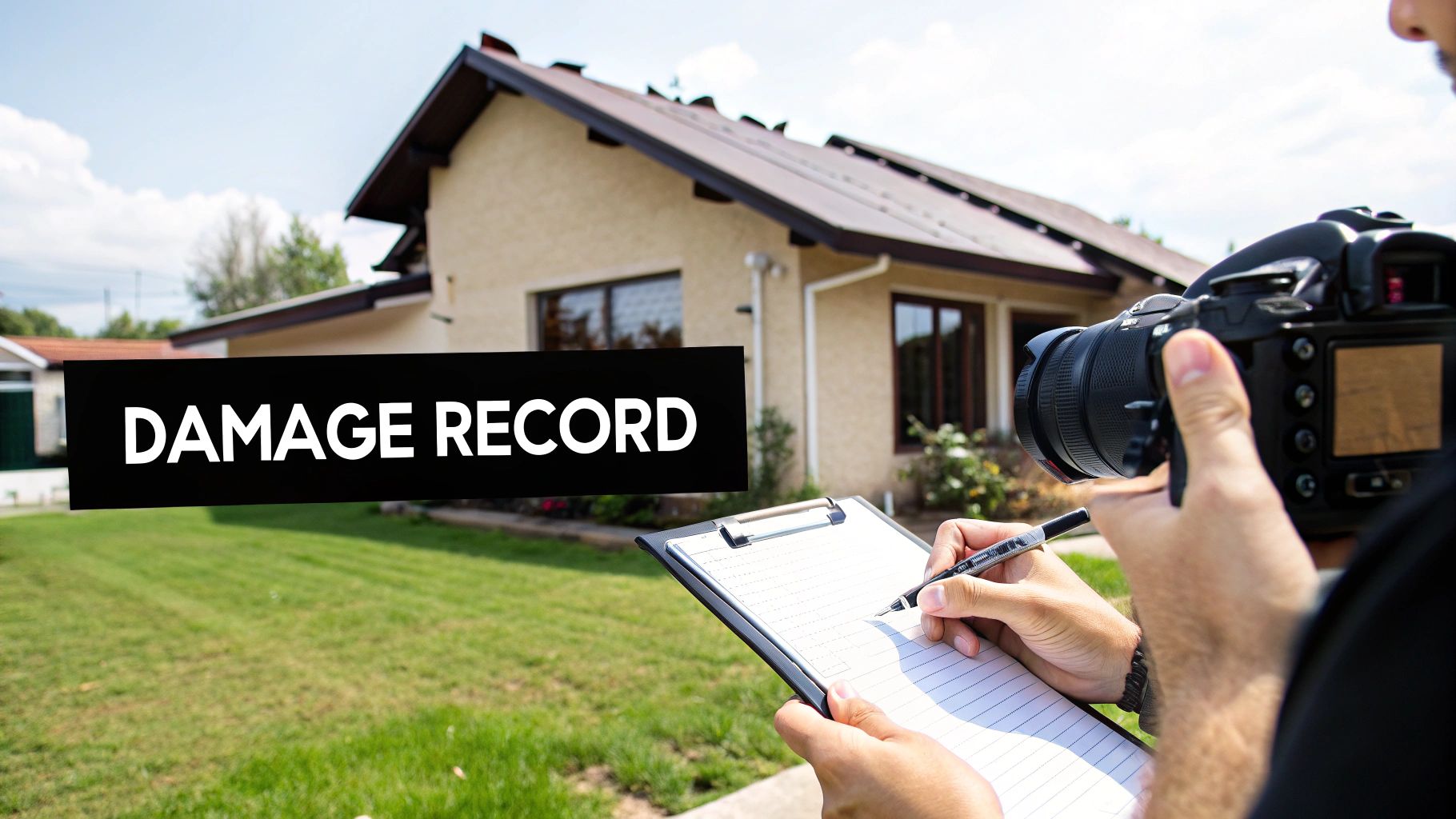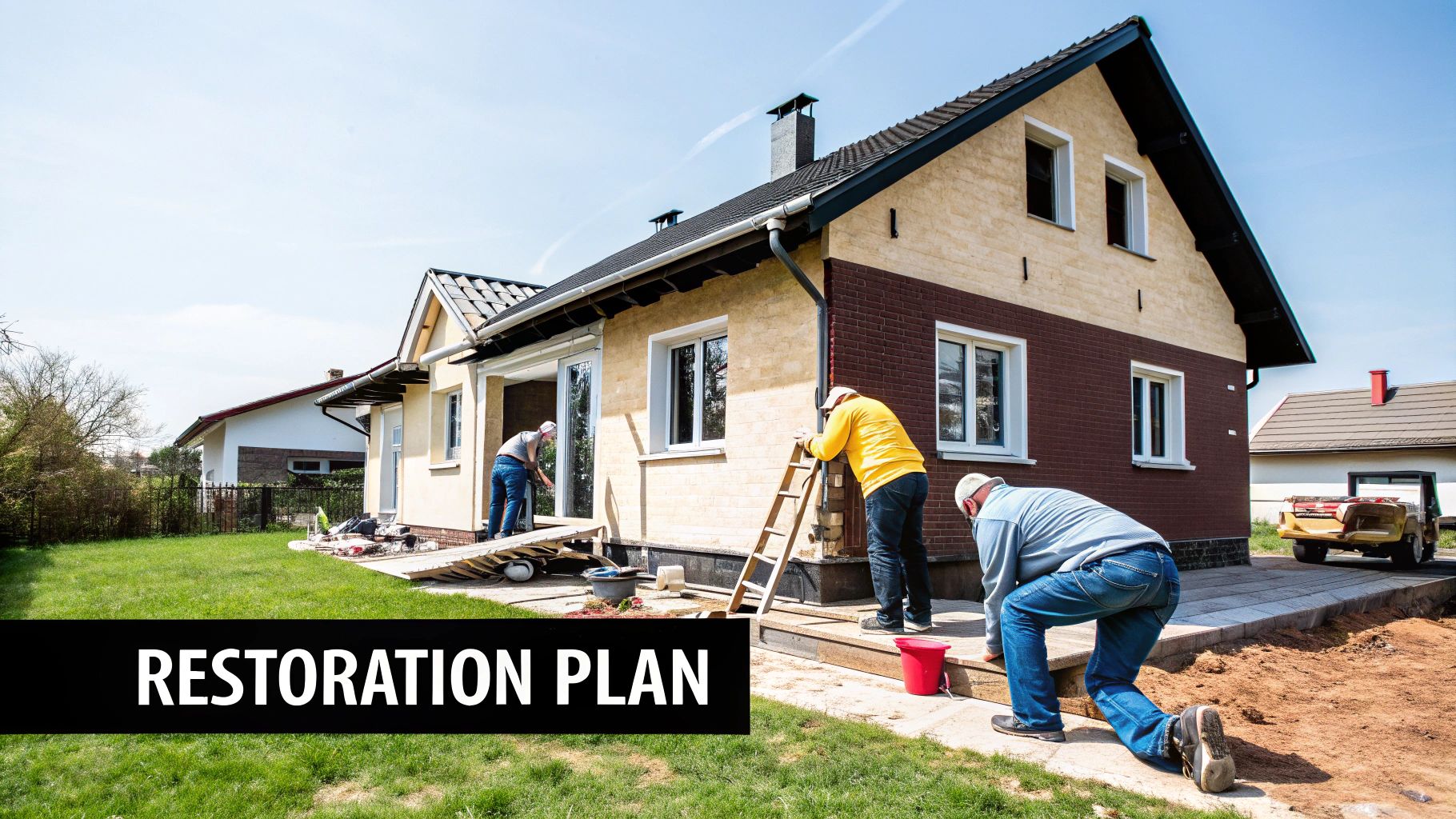Navigating the Home Insurance Claim Maze With Confidence

Filing a home insurance claim can feel overwhelming, especially after experiencing property damage. This section simplifies the process into manageable steps, providing helpful guidance from the initial report to the final settlement. Understanding this process can reduce stress and help you receive the compensation you are entitled to.
Understanding Your Policy and Coverage
Before any unforeseen events occur, take the time to familiarize yourself with your home insurance policy. Knowing your coverage limits, deductibles, and what is specifically included and excluded is essential. This knowledge will help you manage expectations and understand which losses are likely to be covered. Being proactive in this way allows you to approach the claims process with greater confidence. You may find this helpful: What Does Homeowners Insurance Really Cover? Find Out Here.
Taking Immediate Action After an Incident
After an incident, ensuring the safety of everyone involved is paramount. Once safety is secured, contact your insurance company right away to report the incident. Prompt reporting is often a requirement of your policy and officially starts the claims process. For example, if you experience a burst pipe, the first step is to stop the water flow before contacting your insurer. This helps minimize further damage and demonstrates responsible action on your part.
Working With the Insurance Adjuster
The insurance adjuster plays a critical role in your claim. They will assess the damage, investigate the cause, and determine the settlement amount. Understanding their role and how to interact with them effectively is important. Open communication and providing accurate information are essential for a smooth process. Maintaining detailed records of every interaction, including dates, times, and specific details discussed, can be extremely beneficial should any discrepancies arise later.
Documenting the Damage for Your Claim
Thorough documentation is essential for validating your home insurance claim. This includes photographs, videos, and a detailed inventory of damaged or lost items. Remember, property damage accounts for a substantial portion of homeowners insurance claims. In 2022, property damage represented 97.8% of all homeowners insurance claims, underscoring the importance of detailed documentation. You can find more information on homeowners and renters insurance statistics. Accurate documentation strengthens your claim and assists the adjuster in understanding the full scope of your loss.
Documenting Damage That Demands Attention

The evidence you gather after an incident heavily influences the outcome of your home insurance claim. It's not enough to just take a few quick snapshots. You need to methodically build a compelling case that clearly illustrates the full scope of your losses. This thorough documentation will ensure your claim gets the attention it deserves, potentially leading to a quicker and smoother settlement.
Capturing Compelling Visual Evidence
Photos and videos are essential for any strong insurance claim. But simply taking random pictures won’t suffice. Imagine a tree has fallen on your roof. A single, distant shot doesn’t tell the whole story. Instead, take multiple close-up photos of the impact point, the damaged shingles, and any interior damage resulting from the breach.
This detailed visual record provides a much more comprehensive view of the damage. Also, consider including a measuring tape or ruler in the frame to show the scale of the damage and further emphasize its extent. These visual details are crucial for backing up your claim.
Organizing Information Chronologically
Presenting a disorganized collection of photos and receipts can hinder your claim. Organize your documentation chronologically to create a clear timeline of the events and the resulting damage. This makes it much easier for the adjuster to understand the incident’s progression and overall impact.
A clear, structured presentation greatly improves the clarity of your claim. Think of it as storytelling: a logical sequence of events makes the narrative more understandable and compelling. For example, begin with pictures of your property before the incident, if available, then include photos and videos taken immediately after the event. Finally, add documentation of any subsequent repairs or mitigation efforts.
Creating Detailed Inventories and Valuations
In addition to visual documentation, a detailed inventory of damaged or lost items is essential. This inventory should include each item's name, a detailed description, purchase date, original cost, and estimated replacement value.
For high-value items, include receipts, appraisals, or other proof of ownership and value to substantiate your losses and justify your claim amount. Many homeowners understand the importance of this step. In fact, 47% of homeowners document their possessions for potential claims, demonstrating a growing awareness of preparedness. Learn more about homeowners and renters insurance statistics. This also highlights how weather significantly impacts claim frequency, emphasizing the importance of comprehensive coverage.
The following table provides a helpful guide for documenting your claim:
Essential Documentation for Common Home Insurance Claims
A reference guide showing what specific documentation is needed for different types of home insurance claims
| Claim Type | Required Documentation | Helpful Additional Evidence |
|---|---|---|
| Fire Damage | Photos and videos of the damage, fire department report, inventory of damaged items with receipts or valuations | Police report (if arson suspected), witness statements, professional cleaning estimates |
| Water Damage | Photos and videos of the damage, source of the water damage, inventory of damaged items with receipts or valuations | Plumbing reports, evidence of mitigation efforts (e.g., receipts for water extraction services), repair estimates |
| Wind/Hail Damage | Photos and videos of the damage, weather reports, inventory of damaged items with receipts or valuations | Contractor estimates, drone footage of roof damage |
| Theft | Police report, inventory of stolen items with receipts or valuations, photos of any damage caused by the theft | Security footage, witness statements |
This table summarizes the essential documentation needed for various claim types. Having this information readily available can expedite the claims process significantly.
Using Digital Tools to Streamline Documentation
Several digital tools can simplify and improve your documentation process. Home inventory apps make it easy to catalog your belongings with photos, descriptions, and values, making these records easily accessible during a claim.
Cloud storage platforms like Dropbox or Google Drive offer secure backups of your essential documents, ensuring their safety even if physical copies are lost or damaged. Using these technological resources ensures quick and reliable access to your complete documentation, leading to a more efficient claim process. By combining comprehensive documentation with a clear narrative and efficient organization, you build a strong case that supports a fair and timely settlement.
Building Productive Relationships With Insurance Adjusters
The insurance adjuster assigned to your home insurance claim plays a crucial role in determining your settlement. Building a productive relationship with them can significantly influence the outcome. This involves understanding their perspective, communicating effectively, and advocating for your needs respectfully. This section explores strategies for establishing a collaborative relationship that leads to the best possible results.
Strategic Approaches to the Initial Meeting
The first interaction with your adjuster sets the tone for the entire claims process. Be prepared, organized, and proactive. Have your claim number readily available and provide a concise, factual account of the incident. This demonstrates your preparedness and helps establish credibility right from the start.
Clearly explain the extent of the damage and your understanding of your policy coverage. This proactive approach shows you’re informed and engaged. Furthermore, having all necessary documentation readily accessible, such as photos, videos, and inventories, strengthens your position and streamlines the initial assessment.
Effective Communication Without Adversarial Dynamics
While advocating for a fair settlement is essential, maintaining respectful communication is equally crucial. Avoid accusatory language or aggressive tactics. Instead, concentrate on presenting facts and evidence clearly and concisely.
For example, rather than blaming the insurance company, explain the damage and its impact on your life and property. Frame your communication collaboratively, focusing on a mutually agreeable solution.
Remember, the adjuster is a person too. Treating them with respect fosters a more productive working relationship, often leading to a smoother and more efficient claims process. The insurance claims services market, including homeowners insurance, is projected to reach $210.11 billion by 2025, a 13.6% increase from 2024. More detailed statistics can be found here. This growth highlights the increasing importance of navigating the claims process effectively.
Respectfully Challenging Undervalued Assessments
If you believe the adjuster’s assessment undervalues your loss, you have the right to challenge it respectfully. Provide compelling evidence, such as independent appraisals, contractor estimates, or documentation of comparable property values.
Explain your reasoning logically and calmly, focusing on the facts and supporting evidence. If a contractor's estimate is significantly higher than the adjuster's assessment, present the detailed estimate and explain the contractor’s pricing. Highlight any overlooked or underestimated aspects of the damage in the initial assessment. Productive dialogue, supported by strong evidence, is key to a potentially more favorable outcome.
Understanding Adjuster Evaluation Methods and Warning Signs
Familiarize yourself with common adjuster evaluation methods. This knowledge helps you understand their perspective and anticipate potential issues. Be mindful of warning signs, such as significant discrepancies between your estimate and the adjuster’s, unexplained delays, or poor communication.
These situations might warrant consulting with a public adjuster or an attorney specializing in insurance claims. By understanding the process and proactively communicating, you can navigate your home insurance claim confidently and improve your chances of a fair and timely settlement.
Avoiding the Costly Mistakes That Derail Home Insurance Claims

Even seemingly small errors can significantly impact your home insurance claim. Understanding these common pitfalls and how to avoid them can protect your interests and ensure a smoother, more successful claims process. This knowledge can be the difference between a fair settlement and a denied claim.
The Perils of Procrastination: Timing Is Everything
One of the most common mistakes is delaying reporting the damage. Most policies require prompt reporting, and waiting too long can weaken your claim. Immediate action, like mitigating further damage, demonstrates responsible behavior to the insurance company.
For example, if a storm damages your roof, covering the damaged area with a tarp, even temporarily, shows you're taking proactive measures. This demonstrates your commitment to minimizing further loss and can positively influence your claim.
The Power of Words: Careful Communication Is Key
What you say, and how you say it, matters. Be cautious when speaking with the insurance adjuster. Avoid speculating about the cause of the damage or admitting fault.
Stick to the facts, answer questions honestly and directly, and keep a record of all communication. This careful approach ensures clarity and prevents potential misinterpretations that could complicate your claim.
Documenting Everything: Leaving No Room for Doubt
Insufficient documentation is another frequent pitfall. Detailed documentation, including photographs, videos, and a comprehensive inventory of damaged items, strengthens your claim.
However, failing to document existing damage before a new incident can create problems. For instance, pre-existing water damage undocumented before a flood could lead to disputes with your insurer about the extent of the new damage. Thorough record-keeping is crucial.
Renovations and Repairs: Unintended Policy Violations
Making unauthorized repairs before the adjuster inspects the damage can jeopardize your claim. Your policy likely has specific procedures for handling repairs, so always consult your insurer before starting any work.
Additionally, past renovations done without proper permits could lead to issues with your current claim. This highlights the importance of adhering to building codes and obtaining necessary permits for any home improvements.
Understanding Your Policy: Avoiding Coverage Gaps
Misunderstandings about policy coverage can lead to undercompensation. Thoroughly review your policy and understand your deductibles, coverage limits, and exclusions.
For instance, many homeowners are unaware that standard policies often don't cover flood damage, requiring separate flood insurance. Being aware of your specific coverage helps you manage expectations and prepare accordingly.
Seeking Expert Advice: When To Call in Reinforcements
If you're struggling with your claim, consider seeking professional help. A public adjuster can assist with documenting damage, negotiating with the insurer, and maximizing your settlement. An attorney specializing in insurance claims can provide legal guidance if necessary.
Navigating a home insurance claim can be complex. However, by understanding these potential pitfalls and taking proactive steps, you can protect your interests and significantly improve your chances of a successful and fair resolution.
Maximizing Your Home Insurance Claim Settlement
Securing a fair settlement after a covered loss requires a strategic approach. It's more than just filing a claim; it's about understanding the process and advocating for yourself. This section explores advanced techniques to help you receive the maximum appropriate compensation for your covered losses. These insights can make a significant difference in your settlement.
Accurately Valuing Damages Using Industry Standards
One of the first steps in maximizing your claim is accurately valuing the damage. Don't rely solely on the insurance adjuster’s assessment. Research industry standards and typical costs for repairs or replacements specific to your region. Obtain multiple estimates from reputable contractors and compare them to the adjuster’s valuation. This provides a strong basis for negotiation. You might be interested in: How to master finding the best policy.
Identifying Overlooked Claim Components
Many homeowners overlook potential claim components. Beyond visible structural damage, consider additional expenses. These might include temporary housing costs, lost wages due to displacement, and replacing damaged personal belongings. Meticulous documentation of all losses, with receipts and invoices, is crucial.
Hidden Costs and Documentation
Think about less obvious costs too. Debris removal, tree damage cleanup, and increased living expenses if you're displaced during repairs are often legitimate claim components. For example, if your kitchen is unusable due to fire damage, document the cost of eating out.
Presenting Your Case Effectively
How you present your claim significantly impacts the outcome. Organize your documentation logically and chronologically, creating a clear narrative. Use concise language focused on facts and evidence. Instead of general statements, provide specifics. For example, itemize damaged furniture with supporting photos and purchase receipts.
Market Growth and Trends
The global home insurance market was valued at USD 237.7 billion in 2021. Driven by increasing awareness of insurance benefits, it’s projected to reach USD 417.66 billion by 2030, growing at a 7.3% CAGR. Learn more here. This growth highlights the importance of understanding your policy and maximizing your claim.
Utilizing Outside Expertise and Policy Interpretation
For complex or high-value claims, consider engaging a public adjuster. Public adjusters work on your behalf, not the insurance company's. Their expertise can be invaluable in maximizing your settlement. They handle negotiations, documentation, and policy interpretation, allowing you to focus on recovery. Similarly, seeking disability claim help is wise when dealing with such claims.
Understanding Your Policy and Appealing Decisions
Carefully review your policy, focusing on definitions, coverage limits, and exclusions. If you receive an unsatisfactory offer, don't hesitate to appeal. Document your reasons clearly, providing supporting evidence. A well-crafted appeal can often lead to a more favorable outcome. By using these strategies, you can navigate the claims process confidently and secure the compensation you deserve.
Leveraging Technology for Superior Home Insurance Claims

Technology is transforming the home insurance claims process. This exploration delves into how these advancements can expedite and improve your claims experience, ultimately leading to a more favorable settlement. Understanding these tools empowers you to navigate the increasingly digital landscape of insurance claims.
Mobile Claim Apps: Simplifying the Process
Many insurance companies now provide mobile apps that empower policyholders to report claims, submit visual documentation of damage (photos and videos), and track claim progress directly from their smartphones. These apps often facilitate direct communication with adjusters, effectively streamlining the claims process. For instance, instead of coordinating an in-person visit, you can upload real-time video footage. This not only saves valuable time but also allows the adjuster to promptly begin the evaluation process.
Let's examine a comparison of traditional and technology-enabled claim processes to highlight the benefits of leveraging technology.
The following table, "Claim Processing Times: Traditional vs. Technology-Enabled," compares average processing times and customer satisfaction rates between traditional and technology-driven approaches. It provides a clear illustration of how technology enhances efficiency and customer experience within the claims process.
| Claim Process Stage | Traditional Method (Time) | Tech-Enabled Method (Time) | Customer Satisfaction |
|---|---|---|---|
| Initial Report | 2-3 Business Days | < 1 hour | 60% |
| Damage Assessment | 5-7 Business Days | 1-2 Business Days | 75% |
| Claim Evaluation | 7-10 Business Days | 3-5 Business Days | 80% |
| Settlement Offer | 14-21 Business Days | 7-14 Business Days | 90% |
As you can see, the introduction of technology drastically reduces processing times at each stage of the claim, resulting in faster settlements and increased customer satisfaction.
Drone Damage Assessments: A Comprehensive Perspective
Drones are rapidly gaining traction in property damage assessments, particularly for roofs and other inaccessible areas. Drone footage captures a comprehensive overview of the damage, providing compelling evidence to support your claim. Furthermore, drone assessments are conducted swiftly and safely, potentially expediting your settlement.
AI-Powered Evaluation Tools: Improving Accuracy
Some insurance companies are adopting AI-powered tools to evaluate damage and estimate repair costs. These tools analyze images and data to determine the extent of the damage, promoting accurate valuations. This proves especially valuable in complex claims, strengthening the supporting evidence. The global property insurance market, encompassing home insurance, expanded by 32% between 2017 and 2023. Projections indicate further growth of 14% by 2028, reaching USD 770 billion. This data from Statista underscores the increasing importance of home insurance and efficient claims management.
Digital Evidence: Best Practices
When submitting digital evidence, confirm compatibility with your insurer's systems. High-resolution photos and videos provide the most compelling evidence. Always retain the original, unaltered files as backups. Preserving authentic records bolsters your claim's credibility.
Protecting Your Privacy in a Digital Age
While technology streamlines the claims process, safeguarding your privacy remains paramount. Understand the privacy policies of any apps or services you utilize and control data access. For instance, review the data-sharing policies of mobile claim apps before granting access to your device's camera or location. This proactive approach helps protect your personal information.
Your Rights as a Policyholder
Even with increased automation, your rights as a policyholder remain protected. Understand your rights and don't hesitate to inquire about or dispute decisions that appear unfair or inaccurate. You have the right to a clear explanation of how automated systems influence your claim. Your informed participation and open communication contribute significantly to a successful claim resolution.
Preparing Now For Home Insurance Claim Success Later
The most successful home insurance claims begin long before disaster strikes. By taking proactive steps today, you'll significantly improve the chances of a smoother, more favorable outcome in the future. This preparation involves detailed documentation, a thorough understanding of your policy, and smart storage solutions. These measures can minimize stress and maximize your claim settlement when the unexpected occurs. Read also: How to master the home insurance market.
Conducting A Thorough Home Inventory
A detailed home inventory is the cornerstone of any successful insurance claim. This record acts as verifiable proof of your possessions and their value. Don't simply list items; describe them thoroughly, including brand names, model numbers, and unique identifying features.
-
Photographs and Videos: Supplement your written inventory with clear photos and videos of each room and its contents. This visual record provides undeniable proof of ownership.
-
Receipts and Valuations: Keep receipts for major purchases, especially for electronics, jewelry, and appliances. For high-value items like artwork or antiques, obtain professional appraisals.
Maintaining Crucial Documentation
Organize your insurance policy, receipts, and inventory in a safe, easily accessible place. Consider a fireproof safe or a secure cloud storage service like Dropbox or Google Drive. This ensures your documents survive even if your home is damaged.
- Digital Copies: Scan important documents and store digital copies on a secure cloud platform or external hard drive. This provides a backup if physical copies are lost or damaged.
Identifying And Addressing Coverage Gaps
Carefully review your home insurance policy to understand your coverage limits and exclusions. Many standard policies don't cover flood damage. If you live in a flood-prone area, consider purchasing separate flood insurance through the National Flood Insurance Program.
- Regular Policy Review: Regularly review your policy, especially after significant life changes such as home renovations or acquiring valuable possessions. Ensure your coverage adequately reflects your current needs.
Implementing Preventative Maintenance
Proactive home maintenance can prevent future claims and potentially lower your premiums.
-
Regular Inspections: Regularly inspect your roof, plumbing, and electrical systems for potential issues. Address problems promptly to prevent them from becoming larger, more costly claims.
-
Seasonal Maintenance: Perform necessary seasonal maintenance, such as cleaning gutters and trimming trees near your house. This can minimize the risk of damage from storms and falling debris.
By implementing these strategies, you can transform a potentially overwhelming claims process into a manageable and ultimately more successful one. Preparation is key, not only to simplify the claims process but also to potentially receive a better settlement.
Comments are closed.